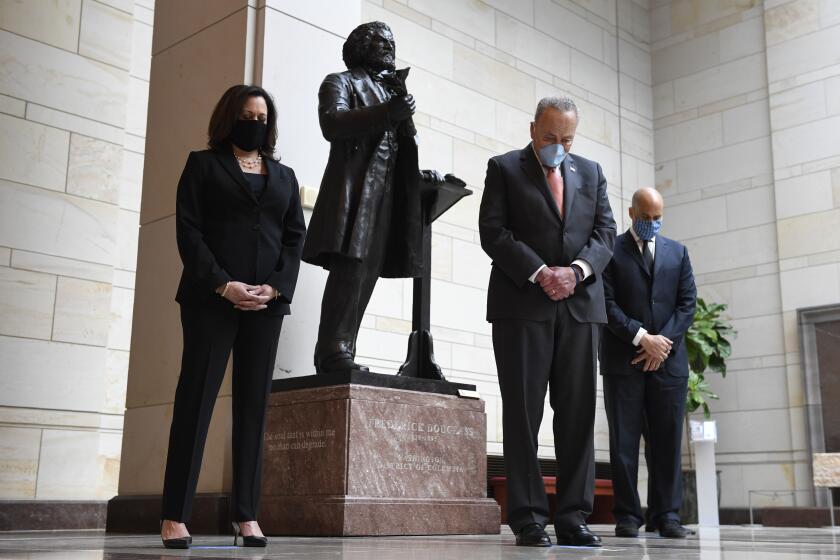A state in the rearview mirror
They said, “Go west,” but many Californians are going north and east.
For the fourth year in a row, more residents left the Golden State than moved here from other states, according to a report released Wednesday by the California Department of Finance.
The outflow -- last seen during the economic and social struggles of the 1990s -- started when it became too expensive for most people to buy homes in the state, and has kept going throughout the bust with the loss of so many jobs.
The trend underscores the state’s sour economy as layoffs continue, the fiscal strain on government grows and home values continue to decline.
Though more births and rising international immigration helped boost California’s population a modest 1.16% last year, the state continued its steady stream of domestic out-migration -- the movement to other states of people who live here.
During the last fiscal year, 135,173 more people moved out of California than moved in from other states. Though just a drop in the bucket for a state of 38 million people, the trend remains significant because such declines usually occur when working Californians decide better opportunities lie elsewhere.
“I just gave up,” said Grace Bryant, a former Glendora resident who fled to Texas after 18 months without consistent employment as a residential appraiser. “California is too much of a struggle.”
Like Bryant, many of those who left California went to Texas, according to truck rental company U-Haul International Inc.; other popular states were Nevada, Arizona and Washington.
The company said that, as of late November, 0.5% more rentals were hired this year to leave the state than to move into it -- 0.2 percentage points higher than last year’s figure.
Before writing the state’s obituary, however, critics might note that a study released Wednesday by the Pew Research Center bolsters the notion of California’s high desirability, showing that most native Californians prefer to remain in the state.
Though California is often depicted as a bastion for the rootless, 69% of native residents 18 and over still live here -- showing stability exceeded only by Texas, North Carolina and Georgia.
Still, the departure for other states of so many residents is serious enough to concern policymakers, who worry about the drubbing that California is taking in the recession.
The current spate of domestic out-migration began in 2005 after six years of continual domestic growth. The trend coincided with the developing housing bubble, which peaked in 2007 when median home values in Southern California reached $505,000.
“This was the epicenter of the housing meltdown,” said John Husing of Economics & Politics Inc., a regional economic research firm. “People started leaving California because of housing prices -- particularly younger couples that just couldn’t afford to buy a house.”
But then the bubble burst and Californians were faced with a new crisis -- joblessness.
The state’s 8.2% unemployment rate is 1.5 percentage points higher than the national rate.
The Riverside, San Bernardino and Ontario area -- one of the areas hit worst by the real estate collapse -- features the highest unemployment rate of any large metropolitan area in the country at 9.5%.
The Los Angeles, Long Beach and Santa Ana area is fifth-worst at 7.7%.
“I think [last year’s out-migration] was because of the very high unemployment,” Husing said. “That’s what will be driving it now. There’s no question we’ll continue to see people leave.”
Fourteen years ago, California was in the middle of another job crisis. The aerospace industry had folded, jettisoning highly trained workers and crippling the local economy built around them.
In 1994, 362,374 more people left the state than moved in. The decline would not reverse course until 1998.
Husing said more people left California during that downturn compared with the current one because there were aerospace jobs in other states. But workers in construction, real estate and related fields hurt in the current downturn have no place to go.
“Where are you going to work in construction anywhere in the country now?” Husing said.
Bryant, the residential appraiser who moved to Texas, said she did not want to leave California. She simply could no longer afford to stay.
“I miss Old Town Pasadena and the dog park in San Dimas,” said Bryant, 51, whose sister and former husband also left Southern California for Frisco, a suburb of Dallas. “But what else am I going to miss? The traffic? Graffiti?”
The string of out-migration has added fuel to a decades-old debate about California’s perceived decline.
In an article last month in the American magazine, urban historian Joel Kotkin contended that the loss of residents reflected a state in trouble. He blamed a Byzantine state government system, a failure to identify the housing crisis and a growing division between rich and poor.
“Today our Golden State appears headed, if not for imminent disaster, then toward an unanticipated, maddening and largely unnecessary mediocrity,” Kotkin wrote.
Historian and author Mike Davis, whose 1990 book “City of Quartz” seemed to foreshadow the social chaos that erupted with the 1992 L.A. riots, said he felt a similar undercurrent of anxiety today because of a dearth of reliable jobs.
“There’s a very large population who are trapped with nowhere to go forward,” Davis said.
Husing dismissed the pessimism.
The native Californian said the state had always priced out the working class and been an expensive place to do business, yet it continued to reinvent itself through innovation and entrepreneurship.
“It’s the hallmark of the California economy,” Husing said. “We attract risk takers. Immigrants from all over the world come here.”
--
Times staff writer Rich Connell contributed to this report.
More to Read
Get the L.A. Times Politics newsletter
Deeply reported insights into legislation, politics and policy from Sacramento, Washington and beyond. In your inbox three times per week.
You may occasionally receive promotional content from the Los Angeles Times.










